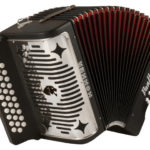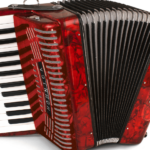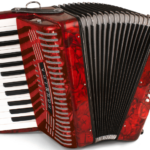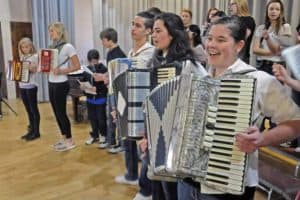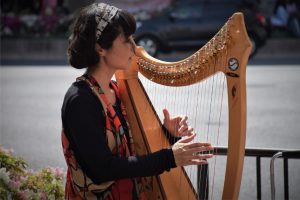The origin of the accordion is contested by several countries. Who invented the accordion? Where did the accordion originate?
The accordion is one of several European inventions of the early 19th century that use free reeds driven by bellows.
The most basic form of the accordion originated in Europe in the early 1820s. It was one of several European inventions of the 1800s that used free reeds controlled by bellows.
The inventor of this accordion is said to be German musical instrument maker Christian Friedrich Ludwig Buschmann in 1822.
The accordion was first patented in 1829 by Cyrill Demian, of Armenian origin, in Vienna.
Russian researchers have claimed they invented the accordion around the same time; however, evidence for this is inadequate.
Read on to learn more about the origin of the accordion, including when it was invented, where it was invented, and who invented it.
Also, for an excellent entry-level accordion, take a look at the Hohner Panther G/C/F 3-Row Diatonic Accordion. It’s reasonably priced, is lightweight, has a great sound, and is great for beginners.
Click here to see this Hohner accordion on Amazon.
Where Did the Accordion Originate? Who Invented the Accordion?
The most basic form of accordion originated in Europe in the early 1820s. It was one of several European inventions of the 1800s that used free reeds controlled by bellows.
The majority consensus is that the inventor was German musical instrument maker Christian Friedrich Ludwig Buschmann in 1822.
There is more evidence of this than all other claims. In his well-documented family history, Buschmann mentioned the musical instruments he invented. One of them had features like that of the accordion.
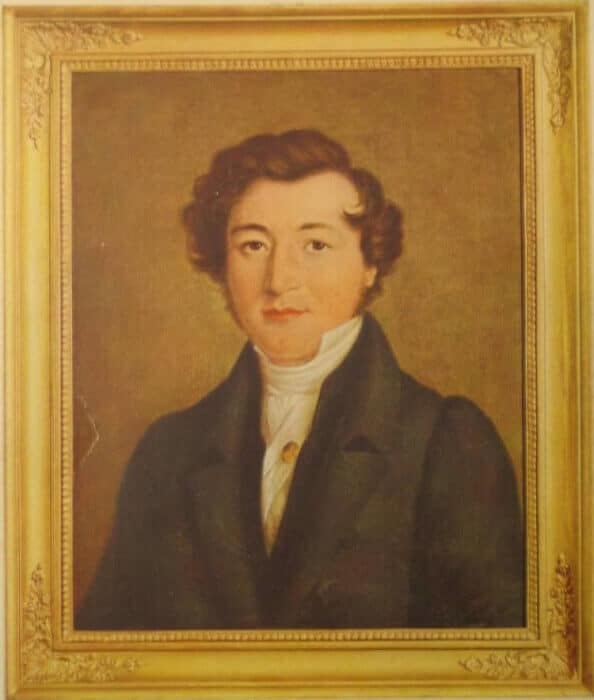
The accordion was first patented in 1829 by Cyrill Demian, of Armenian origin, in Vienna.
According to Russian researchers, the accordion inventor was businessman Timofey Vorontsov. Vorontsov built the first-ever accordion manufacturing facility in Russia. A decade later, businessman Ivan Sizov built his own accordion manufacturing plant too. By the 1840s, Russia was producing a total of 10,000 accordions on a yearly basis.
By the 1860s, new manufacturers of accordions emerged in Russia. After a decade, the country was already producing more than 700,000 accordions per year. Thus, the accordion was once the most popular musical instrument among Russians.
Russian researchers may be correct to assert that accordions originated from their country. But the fact that it was popular in Russia in the 1800s doesn’t officially confirm this. Besides, Sizov acquired his first accordion from Germany. It was his inspiration to create his own version. Thus, it’s possible that the accordion indeed originated in Berlin.
Interestingly, the official documentation of the accordion occurred in neither Germany nor Russia. Instead, it was in Vienna, Austria, in 1829. This was when Armenian inventor Cyrill Demian acquired its first patent.
With Demian’s invention, the left hand only operated the buttonboard. Whereas, the right hand only operated the bellows. His accordion could play an entire chord by depressing a single key. It made it unique from the other accordions during that time. This made him realize he should get it patented.
Another reason for getting a patent was that his accordion could play two different chords at the same time by depressing one key only. The direction of the bellows made it all possible. It also featured bass and treble sections. At that time, musicians described his invention as the most improved version of the accordion.
Russia and Austria were the pioneers of big accordion manufacturing facilities. But it was Germany that brought the accordion to other countries. In 1828, the Germans launched it in Great Britain. Then, in 1831, “The Times” newspaper featured it as the latest musical instrument in the country.
In the beginning, the British audience didn’t receive it well. But “The Times” publication greatly contributed to its popularity. Soon, the accordion reached the United States. By the mid-1840s, it became a popular instrument in New York.
In essence, Germany played a vital role in the success of the accordion business. Many musical instrument makers seemed to draw inspiration from German accordions. It is for these reasons that most musical historians would answer Germany when asked where did accordions come from.

The Popularity of Accordions
We’ve now looked at where accordions originated. Now I want to look at the popularity of the accordion across different countries to see how its use has spread around the world.
Australia
It was in the 1830s when the accordion instrument appeared in music for the very first time. This occurred in Australia when the accordion started competing against other reed instruments. Among the popular instruments at that time were melodeon, concertina, and mouth organ.
One of the first known accordion composers was Australian Frank Fracchia. Among his works were the following:
- Dancing With You; and
- My Dear, Can You Come Out Tonight?
Australian libraries keep the original copy of these works.
Australian composer Reginald Stoneham also had a great contribution to the instrument’s popularity. He arranged music for the accordion. He became popular for his jazz and ragtime musical styles.
In Australia, the accordion was the favorite instrument of buskers. Its popularity was at its peak between the 1930s and 1950s.
Bosnia and Herzegovina
If you ask people in Bosnia and Herzegovina where did accordions originate or who invented the accordion, many would likely answer Bosnia and Herzegovina. This is understandable because the accordion is their national instrument.
In Bosnia and Herzegovina, the accordion is widely used in sevdalinka performances. Sevdalinka is a folk music genre that originated from this country.
Brazil
The accordion had a huge role in the history of Brazilian music. Try to ask Brazilians where did accordions come from, and many would most likely say that it originated from their country. When in fact, Germans and Italians introduced it to them. This transpired when some Europeans migrated to Brazil.
Most European immigrants settled in Parana, Santa Catarina and Rio Grande do Sul. The first type of accordion introduced in Brazil was the concertina. It was a chromatic accordion featuring 120 buttons. It was in the 1950s when its fame was at its peak.
A chromatic accordion, which I’ll go into more detail later, is a type of button accordion where the melody-side keyboard is made up of rows of buttons arranged in a chromatic fashion. Entry-level chromatic accordions usually only have 46 buttons arranged chromatically.
It’s true that the accordion didn’t originate from Brazil. But Rio Grande do Sul recognized it as the state’s official symbol instrument. In fact, almost a hundred accordion manufacturing facilities opened in Brazil. Most of them were in Rio Grande do Sul.
One of the most famous manufacturers was Acordeões Todeschini. It was in Bento Gonçalves, Rio Grande do Sul. The business closed in 1973. But, up until now, the popularity of Todeschini accordions continues. In fact, there are still Todeschini accordions that exist. A few musical instrument shops are still willing to provide their maintenance services.
There are many notable accordionists from Brazil. Some of the most famous accordion players include Edson Dutra, Albino Manique, and Renato Borghetti.
In some countries, the accordion forms part of traditional folk music. But in Brazil, it even forms part of pop music. In fact, the country regards it as the most popular melodic instrument.
In Forró events, the principal musical instrument is the piano accordion. The notable piano accordionists from northeast Brazil include the Dominguinhos and Luiz Gonzaga. Their musical style is usually accompanied by other musical instruments. Among these are the zabumba and the triangle. Now, this musical style is also popular in southeast Brazil.
In southeast and midwest Brazil, the accordion is always a part of various music styles. These include the Sertanejo and Caipira music. Now, the entire country has adopted it.
Colombia
Perhaps, you’d want to ask Colombians too if they know the origin of the accordion or who invented it. Again, many would misperceive their country as its place of origin. This is because the accordion also forms part of their traditional music. It usually forms part of the cumbia and vallenato music genres.
However, it’s interesting how Colombians play the accordion with versatility. They’re comfortable in incorporating the instrument in different music genres. For instance, tropipop musicians feature the accordion in the music. Some of the notable accordion players who do are Bacilos, Fonseca, and Carlos Vives.
The rock music genre features the accordion too. In fact, Juanes is one of these rock musicians. In pop music, Shakira is one of the musicians who feature the accordion.
Aside from all these, Colombians also hold competitions for accordionists. A well-known contest is the one at the Vallenato Legend Festival. Colombians hold this festival, called the Cradle of Accordions festival, on an annual basis.
Also, the festival conducts a major competition every decade. In which case, the contestants are the winners for the last ten years. Indeed, the Vallenato Legend Festival conducts the largest competition for accordionists worldwide.

Mexico
The accordion forms part of several music genres in Mexico. Under the cumbia genre, musician Celso Piña made it popular. Under the norteño genre, musician Ramón Ayala contributed to its popularity. In fact, Mexico regards Ayala as its King of the Accordion.
Mexican musician Julieta Venegas features the accordion in her music. Her versatility allows the incorporation of the instrument in different genres. These include folk, pop, and rock music. Her inspiration was the Los Lobos, a band that also incorporates the instrument in their music.
North Korea
North Koreans regard the accordion as “the people’s instrument.” In fact, there was a time when teachers in this country were all required to learn the instrument.
The book “Nothing to Envy,” by Barbara Demick, takes note of this fact.
Types of Accordions
It’s not enough that we only talk about where accordions originated from. Let’s also discuss the different types of accordions. They include the following:
- The Piano Accordion
- The Button Accordion
- The Unisonoric Accordion
- The Bisonoric Accordion
- The Diatonic Accordion
- The Chromatic Accordion
Piano and the Button Accordions
All accordions feature a buttonboard on the left side. But not all accordions have a buttonboard on the right side.
In the case of the Button Accordion, both the left and the right sides have buttons. This means that even the treble side — which is the right side — features a button board.
In the case of the Piano Accordion, the treble side features piano keys. That way, your right-hand moves as if you’re playing the piano. Whereas, your left hand operates the chords by depressing buttons.
The TV show, “The Lawrence Welk Show,” also contributed to the success of the Piano Accordion. Its host, Lawrence Welk, was an accordionist. He and the Diero Brothers opened an opportunity for other musicians. Musicians realized that they too could play this instrument. Most of them were, of course, pianists and keyboardists.
The Piano Accordion became well accepted in the U.S. because of Welk and the Diero Brothers. In fact, the country recognized it as the most famous type of accordion in the 20th century.
The Hohner Panther G/C/F 3-Row Diatonic Accordion is an example of a popular entry-level diatonic button accordion. It’s reasonably priced, is lightweight, and has a great sound.
Click here to see this Hohner accordion on Amazon.
Unisonoric and the Bisonoric Accordions
The terms “unisonoric” and “bisonoric” describe how the bellows produce pitches and notes. In essence, sound production results from the direction of the bellows. Also, it results from how the air moves through the reeds.
Try playing a unisonoric accordion. Move the bellows in any direction while depressing one key. Observe how the sound it creates doesn’t change its pitch.
Then, try doing it too using a Bisonoric Accordion. Try to push in and pull out the bellows while you depress a key. Notice how the pitch changes as you continue to do this.
Diatonic and the Chromatic Accordions
In essence, the Button Accordions have two types. They are:
- Diatonic Accordion; and the
- Chromatic Accordion.
In the case of the Diatonic Button Accordion, it has three rows of buttons or less. In most cases, it’s available in the Bisonoric model. That way, it can produce different sounds even if it only has a few buttons. But for musical performances, the sound it produces isn’t enough. There are keys that are impossible to reach by the Diatonic Accordion alone. You will need other musical instruments to go with it.
In the case of the Chromatic Button Accordion, it features as many as five rows of buttons. Unlike the Diatonic type, this one’s available in Unisonoric in most cases. This means each key produces a single pitch regardless of the direction of the bellows. Various music genres feature this type of accordion. These include the Russian bayan music and the French musette music.
There’s also a Unisonoric Chromatic Piano Accordion. In most cases, Italian and German music features this type of accordion. Musical instrument makers introduced it in the 20th century. It was a few years after they invented the Diatonic Button Accordion.
Conclusion – Who Invented the Accordion? Where Did the Accordion Originate?
The earliest known evidence of the origin of the accordion was about 200 years ago, in 1822, by German music maker Christian Friedrich Ludwig Buschmann.
Russian researchers have claimed they invented the accordion around the same time. They make this claim based on the popularity of the accordion in the 1840s and businessman Timofey Vorontsov who built the first-ever accordion manufacturing facility.
In many other countries, such as Brazil, Bosnia and Herzegovina, Columbia, and more, you will hear people say the accordion originated in their country. But the earliest known evidence was the German music maker in 1822.
The accordion has spread around the world, and it is quite amazing how it has become so beloved by so many people. It seems to become a part of a country’s national identity. Here’s to another 200 years of accordion music!
Related reading:
8 Best Lightweight Accordions for Beginners and Pros
How Much Does an Accordion Weigh?
What Type of Accordion is Easier to Play: Button or Accordion?




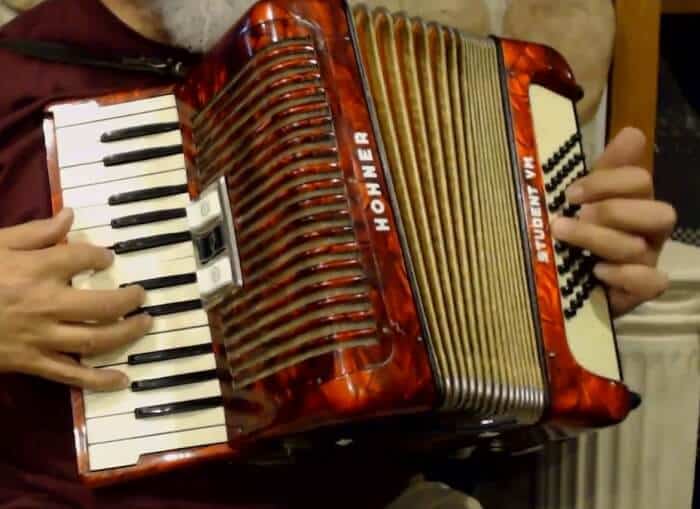
![Accordion-like Instruments [Full List] accordion like instruments](https://musicalinstrumentpro.com/wp-content/uploads/2022/09/accordion-like-instruments-150x150.jpg)
